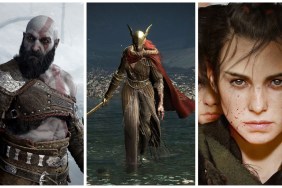A bridgehead over troubled watercolors.
Over the years, we’ve seen literally hundreds of war-themed games whose realistic, convincing (or otherwise eye-pleasing) visuals might have obliged us to call them ‘beautiful’ (irrespective of how grim or scary the game’s world or subject matter was). There have even been scores of (obviously far less-serious) war-themed games that could be called ‘cute’ (the Worms series, just for example, or any of the Advance Wars titles you choose to pick—at least up until you hit Days of Ruin, anyway); and of course, there’s that relative handful that fall into the ‘drop dead gorgeous’ category… but there aren’t many that come to mind that I would actually call ‘pretty’. Valkyria Chronicles, however, fits that description: Even at an over-attended, over-structured editor’s day at Sega’s San Francisco offices (that started too early in the morning, following a night of way too little sleep), this unique, visually dazzling tactical combat game was just too pretty to not look at.
[image1]The first thing you’ll notice about Valkyria Chronicles is the unusual visual presentation, courtesy of the proprietary “CANVAS” engine. While the art style for environments and characters is textbook Anime, the engine gives the apparent ‘technique’ of inked, hand-drawn lines filled with soft hues redolent of colored pencils or watercolors; the maps of the various battlegrounds—indeed, the entire progression of the story—is told through these same kinds of storybook images, with colors fading off at the edges of the ‘page.’
As good as any given still screen-shot of this game that you might see looks, trust me, it all looks better in motion—so much so that you wouldn’t get many funny looks if you compared its visual quality to that of any Studio Ghibli production. It’s even got that wonderful familiar-yet-askew, timeless look that so many Studio Ghibli films have—at any given moment, you’re never quite sure if the next thing over the nearest rise is going to be some kind of funky steam-punked vision of a pre-WWII-era Nazi tank, or a horse-drawn cart from a not-so-long-past rural age…and neither one would surprise you all that much.
The game tells the tale of Gallia, a tiny republic in what appears to be an alternate-history (albeit very recognizable) Europe, circa 1930—countryside, architecture, family names, tech levels and all (only the faces, hair and general snappy, mod-military fashion sense appear overtly Japanese). Gallia has the bad luck to be caught in the gears of a massive land-war between two neighboring super-powers—the East European Imperial Alliance, and the Atlantic Federation. It seems that Gallia is home to rather large reserves of the all-important Ragnite ore, which has great potential to be used not only for warfare, but for positive applications as well. Players control a group of young Gallian nationals who decide to pick up guns (for the first time, it seems) and try to repel the invasion.
[image2]Valkyria Chronicles’ battle system (dubbed “BLiTZ”—Battle of Live Tactical Zones) does away with the expected hex/square grid-based schemes of so many other games, employing instead a system closer to what some board- and miniatures-gamers would call Action Points. In Action Mode, movement and any other activities are dealt with in a follow-cam view and in real time, limited by each character’s particular action gauge. For every step your active character takes, the gauge drops, but it can re-charge during a turn in which you are commanding other characters. During Target Mode, players can directly command characters to aim for head shots or perform other critical functions.
As with the types of board games that use an AP system, blundering into enemy units or across their lines of fire will allow said enemies to crank off a few reactionary snap-shots – even when it’s not their turn. And you certainly don’t want to end your Action Mode turn out in the open, or any more vulnerable to the enemy than you need to be. On the battlefield, commanding units requires Command Points—they can be judiciously spread out among several friendly units, or can be used on the same unit repeatedly, if that’s what the tactical situations calls for.
Each character has specific strengths and weaknesses that play off against those of other unit-types for your typical rock-paper-scissors kind of combat results: tanks kick infantry ass, antitank units kick tank ass, and mobile footsoldier units can get the best of more lumbering antitank outfits under the right conditions. Valkyria Chronicles will offer some 50 characters of various classes (including normal footsoldiers, snipers, heavy gunners, engineers and artillery). Should one of your characters bite the dust in combat, you have two choices: Get a medic to them in three turns to revive them, or let them die –like, really die, for the rest of the game—and limp on without them as best you can (of course, if they’re a key plot character, it’s Game Over and back to the last save-point for you.)
[image3]Another important tactical element is that of ‘control points’—capture these, and they’ll offer your forces certain tactical advantages (and extra places to respawn don’t hurt, either). Get creative in blowing out walls or securing certain access routes on the battlefield and you might be able to flank or otherwise harass the enemy. Commander units can also shape the battle by providing increased morale and calling in artillery strikes. And all the while—it is a Japanese game, after all—your individual characters will have their own RPG-style personality traits, quirks, and preferences that need tending to, be it a predilection for urban environs, a preference for certain types of combat, an allergic aversion to Anime Hair, or whatever. This is war. Cope.
From what we’ve seen, Valkyria Chronicles gives players the best of at least two worlds—a stunning, eye-pleasing anime-styled presentation, and a serious tactical combat seasoned with zesty Japanese RPG sauce (in another nice touch, the US release of the game is expected to have the option for Japanese audio) Valkyria Chronicles is slated to ship in North America this fall, and we’ll be reporting from the front lines with a full review..










